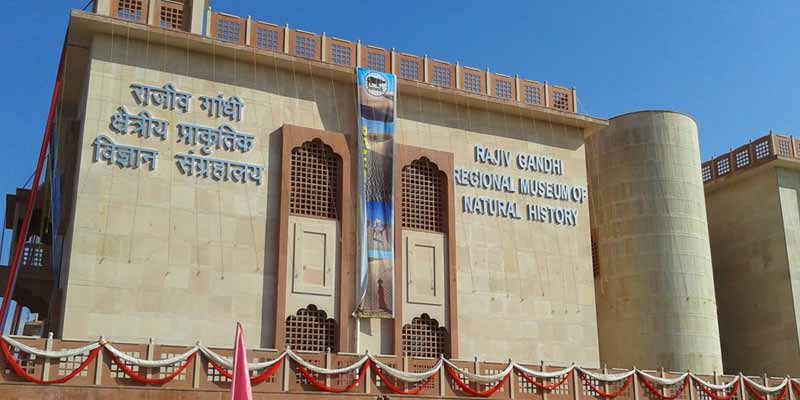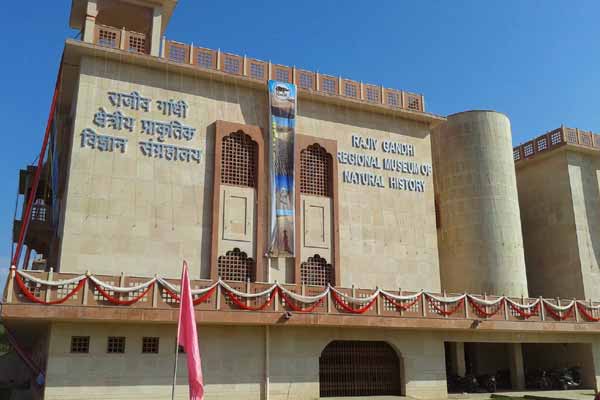Rajiv Gandhi Regional Museum of Natural History, situated near the famous Ranthambore National Park in Sawai Madhopur, Rajasthan, serves as a gateway to understanding the rich natural heritage of western India. Opened in 2014, the museum pays homage to former Indian Prime Minister Rajiv Gandhi’s vision of promoting conservation education and awareness. It stands as a testament to the diverse ecosystems of the region, with a particular focus on the flora and fauna of the Aravalli and Vindhya ranges.
Spread over multiple floors, the museum showcases a wide array of exhibits that include detailed dioramas, informative displays, and interactive sections designed to engage visitors of all ages. From the lifelike representations of various animal species to the vivid depiction of forest habitats, each exhibit is crafted to foster a deeper understanding and appreciation of India’s natural wealth.
The museum not only educates about the biodiversity and ecological challenges of the region but also emphasizes the importance of conservation and sustainable living practices. By blending education with entertainment, the Rajiv Gandhi Regional Museum of Natural History plays a crucial role in inspiring conservation efforts among the public, making it a must-visit for nature lovers and environmental enthusiasts visiting Ranthambore.

History of Rajiv Gandhi Regional Museum
The Rajiv Gandhi Regional Museum of Natural History in Sawai Madhopur, Rajasthan, was conceived as an educational and environmental resource to promote awareness of nature and conservation. Its foundation lies in the vision of bringing the natural world closer to the people, encouraging a harmonious relationship between humans and nature, and fostering an understanding of the environmental challenges facing today’s world. The museum is named after Rajiv Gandhi, the former Prime Minister of India, in recognition of his contributions to environmental conservation and education in India.
The museum, which opened its doors to the public in 2014, was established as part of an initiative by the Indian Government to spread environmental and conservation education among the masses. It was designed to serve as a center for environmental education, where visitors could learn about the biodiversity of Rajasthan and the conservation efforts being undertaken to preserve it. The strategic location near Ranthambore National Park, one of India’s most renowned wildlife reserves, underscores its mission to highlight the importance of conservation, especially of the tiger population for which Ranthambore Tour Packages.
The development of the museum involved meticulous planning and design to ensure that it effectively communicated the complexities of natural history and conservation to a diverse audience. Its exhibits were designed to be interactive and engaging, making use of dioramas, models, and informational panels to depict the natural habitats of the region, its flora and fauna, and the ecological challenges they face.
Since its inauguration, the Rajiv Gandhi Regional Museum of Natural History has become an important educational tool, not only for the local community but also for tourists visiting Ranthambore National Park. Its exhibitions and programs aim to inspire actions that contribute to the conservation of India’s natural heritage. The museum stands as a tribute to Rajiv Gandhi’s legacy in environmental conservation and serves as a reminder of the continuous need for environmental education and the importance of living in harmony with nature.
Places to Visit Near Rajiv Gandhi Regional Museum
The area surrounding the Rajiv Gandhi Regional Museum of Natural History in Sawai Madhopur, Rajasthan, is rich in natural beauty, historical significance, and cultural heritage. If you’re planning a visit to the museum, you’ll find that it can be conveniently paired with several other attractions in the vicinity, making for a fulfilling trip. Here are some must-visit places near the museum:
- Ranthambore National Park
Just a stone’s throw away from the museum, Ranthambore National Park is one of India’s largest and most famous national parks, known for its tiger population. The park offers safari tours where visitors can spot tigers, leopards, crocodiles, and a variety of bird species in their natural habitat. The ancient Ranthambore Fort, located within the park, adds a historical dimension to the visit.
- Ranthambore Fort
Perched atop a hill in the heart of the national park, this UNESCO World Heritage site offers breathtaking views of the surrounding area and a glimpse into Rajasthan’s rich history. The fort’s majestic ruins include temples, palaces, and massive gates, making it a photographer’s delight.
- Trinetra Ganesh Temple
Situated inside the Ranthambore Fort, this temple is dedicated to Lord Ganesha and is a significant pilgrimage site. It’s known for receiving wedding invitations from across India to seek blessings, a unique tradition observed by devotees.
- Padam Talao
This is the largest of the several lakes in Ranthambore National Park, beautifully adorned with water lilies. The Jogi Mahal, located at the edge of the lake, offers a picturesque view, making it a perfect spot for nature lovers and photographers.
- Kachida Valley
Located on the outskirts of Ranthambore National Park, Kachida Valley is known for its panoramic landscapes, dense forests, and the occasional sighting of panthers and bears. It’s an ideal spot for those looking to immerse themselves in nature’s tranquility.
- Sawai Man Singh Sanctuary
Adjacent to Ranthambore National Park, this sanctuary extends the wildlife experience with its rich biodiversity. It’s a less crowded spot for wildlife enthusiasts to explore the region’s flora and fauna.
- Chauth Mata Temple
This temple, dedicated to Chauth Mata, the goddess of fertility and rain, is a revered site located on a hilltop near Sawai Madhopur. Visitors often hike up to the temple to enjoy panoramic views of the surrounding countryside.
- Ranthambore School of Art
This art school is known for its wildlife paintings, especially those featuring tigers. Visitors can admire the artwork, interact with the artists, and even purchase paintings to support wildlife conservation efforts.
Each of these attractions offers a unique experience, ranging from wildlife and natural beauty to historical and cultural explorations, making the area around the Rajiv Gandhi Regional Museum of Natural History a comprehensive destination for travelers.
How To Reach Rajiv Gandhi Regional Museum
Reaching the Rajiv Gandhi Regional Museum of Natural History in Sawai Madhopur, Rajasthan, is relatively straightforward, thanks to its proximity to several major travel hubs and its location near the renowned Ranthambore National Park. Here’s how you can get there:
By Air : The nearest airport to Sawai Madhopur is Jaipur International Airport, which is approximately 160 kilometers away. Jaipur, being a major city, is well-connected to India’s other large cities and some international destinations. From the airport, you can hire a taxi or take a bus to reach Sawai Madhopur. The journey by road takes around 3 to 4 hours, depending on traffic and road conditions.
By Train : Sawai Madhopur Railway Station is a major railhead well-connected to several Indian cities including New Delhi, Jaipur, Mumbai, and Kolkata among others. The town of Sawai Madhopur is just about 10 kilometers from the museum. From the railway station, you can take a local taxi, auto-rickshaw, or even a shared jeep to reach the museum. This is a convenient and popular option given the frequency of trains to Rajiv Gandhi Regional Museum
By Road : Sawai Madhopur enjoys good road connectivity with major cities in Rajasthan and neighboring states. You can opt for state-run buses, private buses, or drive yourself to reach the town. The museum is located on the outskirts of Sawai Madhopur and can be easily accessed by local transport from anywhere in the town. If you’re coming from Jaipur or another nearby city, you might find direct buses or can rent a car for a more comfortable journey.
